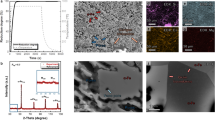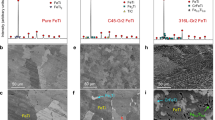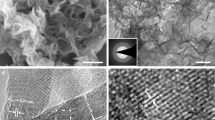Abstract
Recycling iron and steel is critical for environmental sustainability and essential to close material loops in circular economics. A major challenge is to produce high-value products and to control impurities like carbon in the face of stringent consumer requirements and volatile markets. Here, we develop an electrorefining process that directly decarburizes molten iron by imposing an electromotive force between it and a slag electrolyte. Upon anodic polarization, oxide anions from the slag discharge directly on carbon dissolved in molten iron, evolving gaseous carbon monoxide. In a striking departure from conventional practice that highly relies on reaction with solubilized oxygen, here electrorefining achieves decarburization by direct interfacial reaction. We demonstrate that this technique produces ultra-low-carbon steels and recovers silicon as a by-product at the cathode, requiring a low energy input and no reagents. We expect this process to be scalable and integrable with secondary steel mills.
This is a preview of subscription content, access via your institution
Access options
Access Nature and 54 other Nature Portfolio journals
Get Nature+, our best-value online-access subscription
$29.99 / 30 days
cancel any time
Subscribe to this journal
Receive 12 print issues and online access
$259.00 per year
only $21.58 per issue
Buy this article
- Purchase on Springer Link
- Instant access to full article PDF
Prices may be subject to local taxes which are calculated during checkout




Similar content being viewed by others
Data availability
The data supporting the findings of this study are available within the paper and its Supplementary Information files and from the corresponding author upon reasonable request. Charge-transfer resistances, interfacial capacitances, exchange currents, Tafel slopes, rate constants and data from electrorefining trials are given in the Supplementary Information files.
References
Olivetti, E. A. & Cullen, J. M. Toward a sustainable materials system. Science 360, 1396–1398 (2018).
Raabe, D., Tasan, C. C. & Olivetti, E. A. Strategies for improving the sustainability of structural metals. Nature 575, 64–74 (2019).
Stahel, W. R. The circular economy. Nature 531, 435–438 (2016).
Steel Statistical Yearbook (World Steel Association, Brussels, 2021).
Energy Technology Perspectives 2017: Catalysing Energy Technology Transformations (International Energy Agency, 2017).
Strezov, V., Evans, A. & Evans, T. Defining sustainability indicators of iron and steel production. J. Clean. Prod. 51, 66–70 (2013).
Hasanbeigi, A., Arens, M., Cardenas, J. C. R., Price, L. & Triolo, R. Comparison of carbon dioxide emissions intensity of steel production in China, Germany, Mexico, and the United States. Resour. Conserv. Recycl. 113, 127–139 (2016).
Pauliuk, S., Milford, R. L., Müller, D. B. & Allwood, J. M. The steel scrap age. Environ. Sci. Technol. 47, 3448–3454 (2013).
Bouaziz, O., Allain, S., Scott, C. P., Cugy, P. & Barbier, D. High manganese austenitic twinning induced plasticity steels: a review of the microstructure properties relationships. Curr. Opin. Solid State Mater. Sci. 15, 141–168 (2011).
Rana, R. & Singh, S. B. Automotive Steels: Design, Metallurgy, Processing and Applications (Woodhead Publishing, 2016).
Jalkanen, H. & Holappa, L. in Treatise on Process Metallurgy Vol. 3 (eds Seetharaman, S. et al.) 223–270 (Elsevier, 2014).
Battlea, T., Srivastavaa, U., Kopfleb, J., Hunterb, R. & McClellanda, J. in Treatise on Process Metallurgy Vol. 3 (eds Seetharaman, S. et al.) 89–176 (Elsevier, 2013).
Islam, M. S., Rhamdhani, M. A. & Brooks, G. A. Electrically enhanced boron removal from silicon using slag. Metall. Mater. Trans. B 45, 1–5 (2014).
Pal, U. B., MacDonald, S. A., Woolley, D. W. & Powell, A. C. Results demonstrating techniques for enhancing electrochemical reactions involving iron oxide in slags and C in liquid iron. Metall. Mater. Trans. B 36, 209–218 (2005).
Kim, D. H., Kim, W. & Kang, Y. B. Electrochemical transfer of S between molten steel and molten slag. Metall. Mater. Trans. B 49, 1311–1321 (2018).
Kim, D. H., Kim, W. & Kang, Y. B. Electrochemical desulfurization of molten steel with molten slag: reaction rate and current efficiency. J. Electrochem. Soc. 165, E816–E825 (2018).
Novikov, V. K., Toporishchev, G. A. & Grebnev, S. A. Anodic polarisation of cast iron in a slag melt. Russ. Metall. 35–38 (1979).
Bockris, J. O. M. Kinetics of activation controlled consecutive electrochemical reactions: anodic evolution of oxygen. J. Chem. Phys. 24, 817–827 (1956).
Conway, B. E. & Salomon, M. Electrochemical reaction orders: applications to the hydrogen- and oxygen-evolution reactions. Electrochim. Acta 9, 1599–1615 (1964).
Buler, P. I., Esin, O. A. & Nikitin, Yu. P. Influence of composition on the anodic polarization of alloys of iron with carbon and nickel. Sov. Electrochem. 3, 249–253 (1967).
Sotnikov, A. I., Fugman, G. I. & Barmin, L. N. Anodic polarization of iron saturated with carbon in oxide melts. Fiz. Khim. Issled. Met. Protsessov 60–65 (1973).
Woolley, D. E. & Pal, U. B. Experimental evidence for electrochemical nature of the reaction between iron oxide in calcia-silica-alumina slag and carbon in liquid iron. Metall. Mater. Trans. B 30, 877–889 (1999).
Min, D. J. & Fruehan, R. J. Rate of reduction of FeO in slag by Fe-C drops. Metall. Trans. B 23, 29–37 (1992).
Seo, J.-D. & Kim, S.-H. Reaction mechanism of FeO reduction by solid and dissolved carbon. Steel Res. 69, 307–311 (1998).
Chen, E. & Coley, K. S. Kinetic study of droplet swelling in BOF steelmaking. Ironmak. Steelmak. 37, 541–545 (2010).
Conway, B. E. & Conway, B. E. in Electrochemical Supercapacitors 221–257 (Springer, 1999).
Kisza, A. The capacitance of the electric double layer of electrodes in molten salts. J. Electroanal. Chem. 534, 99–106 (2002).
Erdey-Grúz, T. Kinetics of Electrode Processes 34–35, 73–76 (Adam Hilger, 1972).
Shercliff, J. A. Fluid motions due to an electric current source. J. Fluid Mech. 40, 241–250 (1970).
Kelley, D. H. & Sadoway, D. R. Mixing in a liquid metal electrode. Phys. Fluids 26, 57102 (2014).
Jakse, N. et al. Interplay between non-bridging oxygen, triclusters, and fivefold Al coordination in low silica content calcium aluminosilicate melts. Appl. Phys. Lett. 101, 201903 (2012).
Franks, E. & Mukherjee, A. Anion distribution in alkaline silicates. J. Appl. Electrochem. 3, 179–184 (1973).
Strel’tsov, A. K., Esin, O. A. & Toporishchev, G. A. Investigation of reduction kinetics of silicon from molten oxides by potentiostatic method. Sov. Electrochem. 5, 145–150 (1969).
Richardson, F. D. Physical Chemistry of Melts in Metallurgy 495–497, 504–505 (Academic Press, 1974).
Judge, W. D., Allanore, A., Sadoway, D. R. & Azimi, G. E-logpO2 diagrams for ironmaking by molten oxide electrolysis. Electrochim. Acta 247, 1088–1094 (2017).
Baucke, F. G. K. in Handbook of Reference Electrodes 229–241 (eds Inzelt, G., Lewenstam, A., Scholz, F.) (Springer, 2013).
Boukamp, B. A. Electrochemical impedance spectroscopy in solid state ionics: recent advances. Solid State Ion. 169, 65–73 (2004).
Boukamp, B. A. A linear Kronig-Kramers transform test for immittance data validation. J. Electrochem. Soc. 142, 1885–1894 (1995).
Acknowledgements
G.A. gratefully acknowledges financial support from the Natural Sciences and Engineering Research Council of Canada (grant no. 503603), Ontario Centres of Excellence (grant no. 503616) and Tenova Goodfellow (grant no. 503604). We sincerely thank V. Scipolo and E. Malfa (Tenova Goodfellow) for their collaboration and invaluable feedback throughout the project.
Author information
Authors and Affiliations
Contributions
G.A. conceived and supervised the research. W.D.J. and G.A. designed the electrochemical cell and electrochemical testing approach. W.D.J. and J.P. performed the experiments and characterization. W.D.J. analysed the results and draughted the manuscript. All authors contributed to discussing and revising the manuscript.
Corresponding author
Ethics declarations
Competing interests
The authors declare no competing interests.
Additional information
Peer review information Nature Materials thanks Geoffrey Brooks, Uday Pal, Umapada Pal and the other, anonymous, reviewers for their contribution to the peer review of this work.
Publisher’s note Springer Nature remains neutral with regard to jurisdictional claims in published maps and institutional affiliations.
Extended data
Extended Data Fig. 1 Plot of the interfacial capacitance determined by electrochemical impedance spectroscopy against carbon concentration in the alloy.
The strong correlation suggests carbon is associated with adsorbed species on the surface of molten iron.
Extended Data Fig. 2 Anodic polarization curves and exchange currents for Fe–0.45 wt% C at 1600, 1650, and 1700 °C.
Results show a the slope of the fitted lines become steeper with temperature as predicted by Tafel’s equation and b the activation energy for the Tafel exchange current is high (273 kJ mol–1) and consistent with activation control.
Extended Data Fig. 3 Interfacial capacitance of Fe–0.45 wt% C measured by electrochemical impedance spectroscopy as a function of temperature and anodic polarization.
a, Interfacial capacitance at the rest potential strongly increases with temperature which is consistent with pseudo-capacitance caused by adsorbed species on the surface of the electrodes. Double-layer capacitance should hardly change over a small interval of 100 °C. On the other hand, specific adsorption, which causes pseudo-capacitance, requires activation energy and explains the strong effect of temperature. b, Differential capacitance curves of Fe–0.45 wt% C at different temperatures show capacitance values diminish to low values on anodic polarization. As pseudo-capacitance caused by adsorbed intermediates depends on their surface coverage, the results are consistent with the proposed mechanism involving surface coverage of an intermediate approaching zero.
Extended Data Fig. 4 Electrochemical investigation of the cathodic half-cell corresponding to silicon reduction.
a, Schematic illustration of the electrochemical setup (to scale) for investigation of the silicon reduction reaction on a molybdenum electrode in the same slag used for electrorefining. b, Cyclic voltammogram at 1600 °C showing redox reactions for silicon and molybdenum (20 mV s–1, 95% iR compensation, 4th cycle, net charge passed was –0.71 C). c, Steady-state cathodic polarization curves reveal Tafel behaviour for silicon reduction at 1600, 1650, and 1700 °C (curves fully corrected for ohmic drop). d, Arrhenius plot of the Tafel exchange current reveals the activation energy (415 kJ mol–1) for the silicon reduction reaction. e, Diagnostic criteria derived for possible rate-determining steps and surface coverages (θ) of silicon reduction. See Supplementary Note 8 for more discussion.
Supplementary information
Supplementary Information
Supplementary Figs. 1–34, Tables 1–22, Notes 1–14 and video description.
Supplementary Video
Compilation of three parts showing submersion of counter electrodes in slag, gas evolution during operation of the electrorefining cell and raising of the electrodes after electrorefining. The video was filmed from a bird’s-eye view and is presented in real time.
Rights and permissions
Springer Nature or its licensor holds exclusive rights to this article under a publishing agreement with the author(s) or other rightsholder(s); author self-archiving of the accepted manuscript version of this article is solely governed by the terms of such publishing agreement and applicable law.
About this article
Cite this article
Judge, W.D., Paeng, J. & Azimi, G. Electrorefining for direct decarburization of molten iron. Nat. Mater. 21, 1130–1136 (2022). https://doi.org/10.1038/s41563-021-01106-z
Received:
Accepted:
Published:
Issue Date:
DOI: https://doi.org/10.1038/s41563-021-01106-z
This article is cited by
-
Decarbonization options of the iron and steelmaking industry based on a three-dimensional analysis
International Journal of Minerals, Metallurgy and Materials (2023)
-
Decomposition Characteristics of CO2 in Molten Iron and a Novel Process for Carbon-Free Deoxidation of CO2 to Produce CO
Metallurgical and Materials Transactions B (2023)
-
Decarburization of Iron Carbon Droplets with Oxidizing Slag: An Experimental Study to Understand the Effect of Ionic and Electronic Conductivity on Decarburization Kinetics
Metallurgical and Materials Transactions B (2022)



